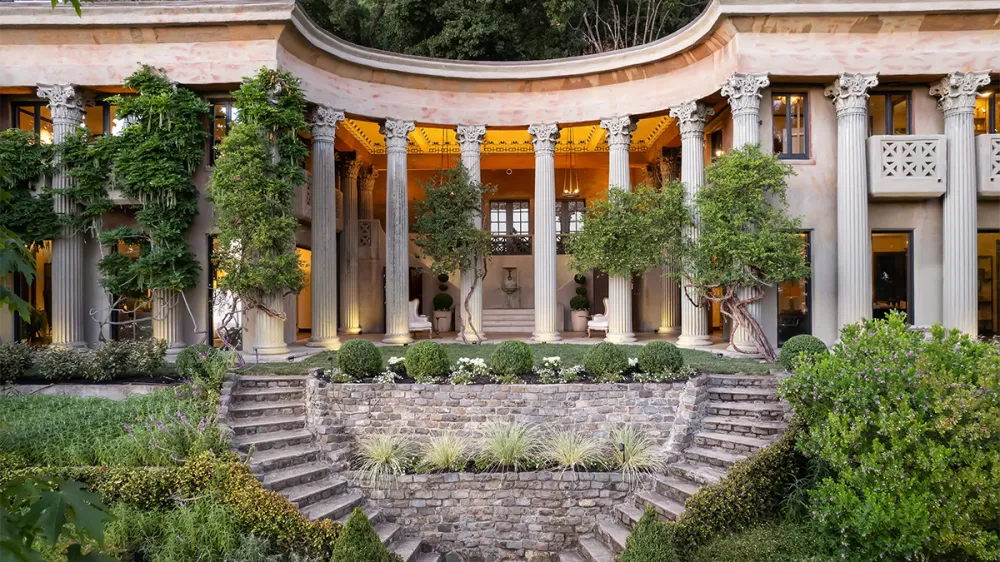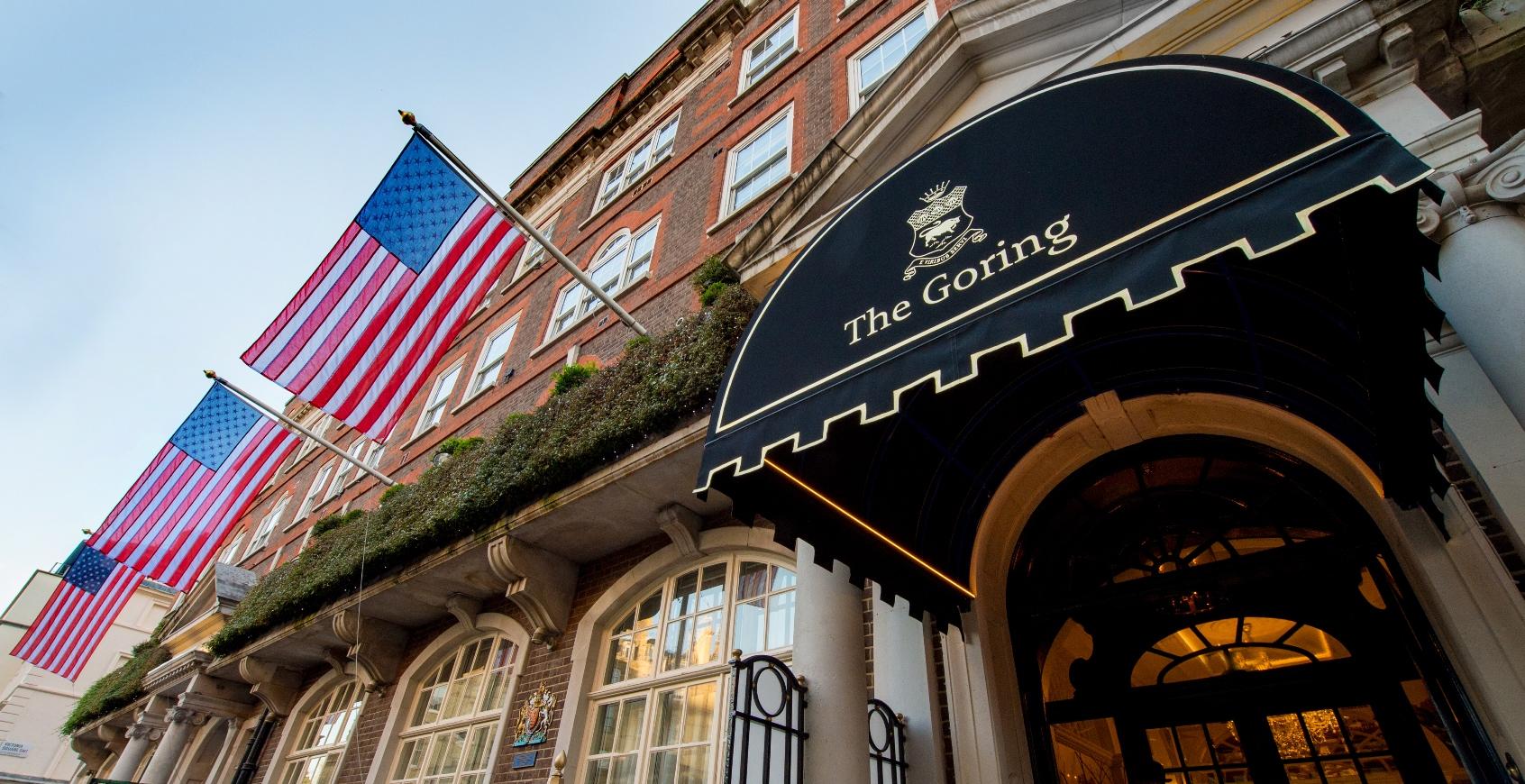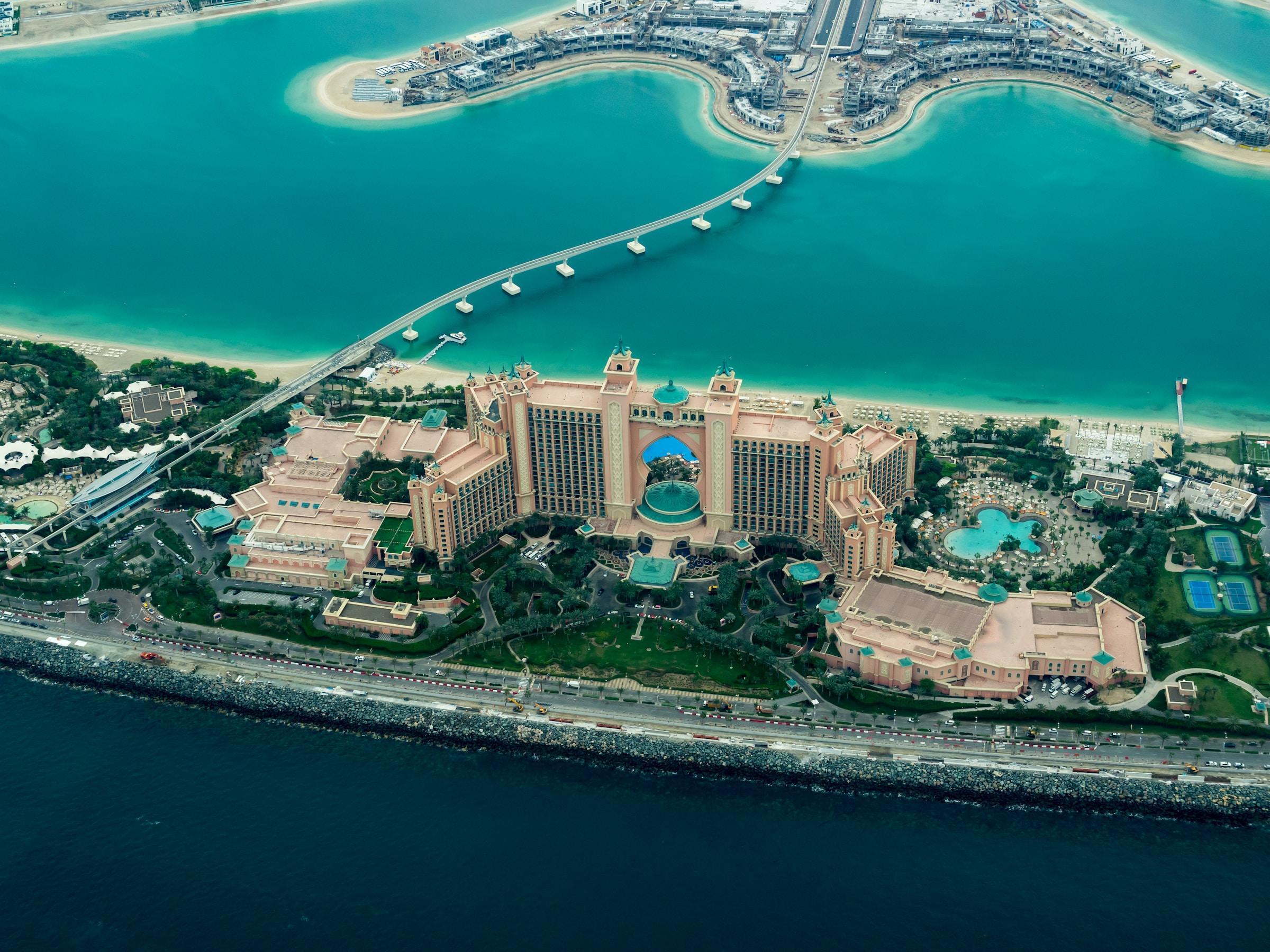Museums, often regarded as time capsules of culture, history, and knowledge, have radically transformed over the years. They no longer simply house static collections of art and artifacts. Instead, museums have embraced the winds of change, evolving into dynamic institutions that engage, educate, and inspire visitors in new and exciting ways.
The Significance of Museums
Museums are more than just repositories of historical relics and artistic masterpieces; they are windows into the soul of humanity. These institutions carry the weight of our collective heritage, acting as storytellers of the past and visionaries of the future. Through their exhibits and attractions, museums bridge the gap between generations, ensuring that the treasures of our world are not forgotten.
Whether you’re a history enthusiast, an art lover, a science buff, or simply someone seeking a memorable experience, museums have something to offer. They allow us to gaze upon the brushstrokes of a genius, marvel at the skeletal remains of prehistoric giants, explore the mysteries of the universe, or immerse ourselves in the rich tapestry of human civilization.
The Role of Museums in Preserving History and Art
Museums have long served as the custodians of history and art, preserving our cultural identity’s tangible and intangible aspects. Each exhibit within a museum is a carefully curated narrative, shedding light on the evolution of societies, the brilliance of human creativity, and the wonders of the natural world.
In a rapidly changing world, museums play a pivotal role in safeguarding our heritage. They protect and conserve irreplaceable artifacts, documents, and artworks, ensuring future generations can witness past achievements. These institutions are like guardians, standing watch over our shared human story, ready to unveil their treasures to curious minds.
But in the 21st century, museums have moved beyond the role of passive preservers. They’ve become active change agents, reinventing themselves to stay relevant in the digital age. Today, more is needed for a museum to collect and display merely; they must engage, educate, and enchant visitors.
The Evolution of Museum Exhibits: From Static Displays to Interactive Journeys
Museums have come far from their early days as somber repositories of dusty artifacts and paintings on lifeless walls. The evolution of museum exhibits is a fascinating journey that reflects the changing dynamics of the cultural and educational landscape. This section will analyze museum exhibits, from their traditional beginnings to the interactive wonders that captivate audiences today. We’ll also delve into how exhibits have adapted to modern technology and the ever-evolving expectations of today’s diverse audience.
The Traditional Museum Exhibit
As we know them today, museums owe their origins to cabinets of curiosity and private collections of the past. These early attempts at displaying rare and unusual objects eventually led to public museums. The traditional museum exhibit was characterized by a static and somewhat sterile presentation of objects. Visitors were often greeted by row upon row of items encased in glass cabinets or hung on walls, with little more than a placard offering a brief description.
The traditional exhibit was informative but needed more engagement to transport visitors to the heart of history, art, or science. It catered primarily to scholars and enthusiasts who sought knowledge and were content with a more passive experience. But as society evolved, so did the expectations of museum-goers.
Embracing Interactivity and Engagement
Museums recognized the need to cater to a broader audience, and this realization led to a transformative shift in the museum experience. Exhibits began to embrace interactivity, creating a dynamic and engaging atmosphere. Several significant developments marked the transition from traditional to interactive exhibits:
Hands-On Experiences
One of the early steps towards interactivity involved providing hands-on experiences. Museums introduced interactive kiosks, tactile displays, and activities encouraging visitors to touch, feel, and explore. This shift allowed visitors to engage with the subject matter more personally, making learning a tactile experience.
Multimedia and Audio-Visual Elements
The introduction of multimedia and audio-visual elements breathed new life into exhibits. These technologies added depth and dimension to the stories, from informative videos to immersive soundscapes. Suddenly, visitors could see artifacts and hear the voices of historical figures or the sounds of ancient environments.
Augmented Reality (AR) and Virtual Reality (VR)
The integration of AR and VR took interactivity to a whole new level. These technologies allowed visitors to enter a painting, walk through an ancient civilization, or explore distant galaxies. Museums harnessed the power of AR and VR to offer previously unimaginable experiences.
User-Generated Content
With the rise of social media, museums started encouraging visitors to become active participants in the exhibit experience. Selfies with famous artworks, check-ins, and user-generated content became integral to the visitor’s journey, turning them into co-creators of the museum narrative.
Meeting Modern Audience Expectations
In today’s fast-paced digital world, the expectations of museum-goers continue to evolve. Audiences seek experiences that are not only informative but also immersive, shareable, and memorable. Museums have embraced these expectations by:
- Providing mobile apps and multimedia guides that enhance the visitor experience.
- Creating interactive and themed exhibits that cater to a diverse range of interests.
- Offering accessibility features that ensure inclusivity for all, including those with disabilities.
- Fostering community and learning through workshops, lectures, and collaborative experiences.
The evolution of museum exhibits mirrors the broader transformation of museums into vibrant, interactive, and inclusive spaces. From static displays to immersive journeys, the world of museums constantly evolves, ensuring that they remain relevant and inspiring for generations to come.
Types of Museums: A World of Diversity and Unique Attractions
Museums are not a one-size-fits-all experience. The world of museums is a rich tapestry woven from the threads of history, art, science, and a myriad of specialized interests. In this section, we will unravel the diversity of museums, from the celebrated halls of art and history to the enchanting domains of science and specialized collections. Each type of museum offers a unique attraction, making them fascinating destinations for curious minds.
Art Museums: Where Creativity Knows No Bounds
Art museums are the most celebrated and well-known of all museum types. These institutions are sanctuaries for creativity, housing some of the world’s most iconic masterpieces. Art museums span the gamut from classical to contemporary, offering visitors the chance to experience the entire spectrum of human expression.
Unique Attractions:
- Masterpieces Beyond Imagination: The Louvre in Paris, the Uffizi Gallery in Florence, and the MoMA in New York house works that have shaped art history.
- Rotating Exhibits: Art museums regularly rotate their collections, ensuring there’s always something new to discover.
History Museums: Unveiling the Tapestry of Time
History museums are time machines that transport us to different eras. They chronicle the stories of civilizations, individuals, and events that have shaped our world. History museums are like open books, inviting us to read the narratives of the past.
Unique Attractions:
- Historical Artifacts: History museums display tangible relics from ancient weapons to royal garments from bygone eras.
- Interactive Timeline Displays: Many history museums use interactive displays to bring history to life, allowing visitors to immerse themselves in different periods.
Science Museums: Unraveling the Mysteries of the Universe
Science museums are portals to the wonders of the natural world and the universe beyond. These institutions explore physics, biology, astronomy, and technology, sparking curiosity about the world around us.
Unique Attractions:
- Planetariums: Science museums often feature planetariums where visitors can journey through the cosmos.
- Hands-On Experiments: Many science museums have interactive exhibits that allow visitors to conduct experiments and learn through exploration.
Specialized Museums: A World of Intrigue
The world of specialized museums is boundless, catering to niche interests and passions. Whether you’re captivated by a particular subject, hobby, or collection, there’s likely a specialized museum dedicated to it.
Unique Attractions:
- Niche Collections: Specialized museums often house unique and rare collections, from antique cars to dolls.
- Expert Knowledge: Visitors can engage with experts and enthusiasts passionate about the subject.
A Glimpse into Specialized Museums:
- The Museum of Miniatures in Lyon, France: This museum displays an extensive collection of miniature art, including tiny paintings, sculptures, and intricate dollhouses.
- The International UFO Museum and Research Center in Roswell, New Mexico: Focused on extraterrestrial phenomena, this museum provides insight into UFO sightings and research.
- The Museum of Bad Art in Massachusetts celebrates “art too bad to be ignored,” showcasing unusual and often comical artworks.
In every corner of the world, museums offer diverse experiences. The beauty of these institutions lies in their ability to cater to a broad spectrum of interests and passions. Whether you’re an art lover, a history buff, a science enthusiast, or someone with a unique hobby, there’s a museum waiting to enchant and enlighten you.
Cutting-Edge Technology in Museums: Revolutionizing the Visitor Experience
Museums, traditionally known as bastions of history and art, have undergone a remarkable transformation thanks to cutting-edge technology. The integration of technology, including augmented reality (AR) and virtual reality (VR), has ushered in a new era of visitor experiences that are immersive, educational, and, above all, captivating. In this section, we will explore the profound impact of technology on museum visits and showcase how several institutions have harnessed its power to enrich the visitor’s journey.
The Impact of Technology on Museums
Technology has breathed new life into museums, offering innovative ways to engage and educate visitors. The impact of technology on the museum experience is profound in several key areas:
1. Augmented Reality (AR) and Virtual Reality (VR)
AR and VR have emerged as the show’s stars, enabling visitors to step into the pages of history or the worlds of art. Museums employ AR and VR to:
- Bring Art to Life: AR applications can animate paintings, allowing visitors to see the artist’s creative process.
- Time Travel: VR technology lets visitors virtually transport themselves to ancient civilizations or historical events.
- Interactive Learning: AR and VR make learning enjoyable, allowing visitors to explore complex scientific concepts or historical narratives through interactive 3D models.
2. Interactive Displays
Interactive touchscreens and displays have become a common sight in museums. These interactive exhibits:
- Encourage Exploration: Visitors can explore artifacts, documents, and artworks in detail by zooming in and out, making for a more interactive experience.
- Learning through Play: Interactive displays gamify the learning process, making it fun for children and adults.
3. Multimedia Presentations
From informative videos to immersive soundscapes, museums use multimedia to:
- Enhance Storytelling: Multimedia elements create an atmosphere and provide context, making the exhibits come to life.
- Detailed Insights: Video presentations offer in-depth explanations of complex subjects, making them more accessible to visitors.
4. Mobile Apps and Guides
Museum apps have become essential tools for visitors:
- Enhanced Experience: Apps provide detailed information about exhibits and enable self-guided tours.
- Accessibility: Visitors can delve deeper into the content, translating descriptions and gaining a better understanding of the exhibits.
Examples of Museums Effectively Using Technology
1. The British Museum, London
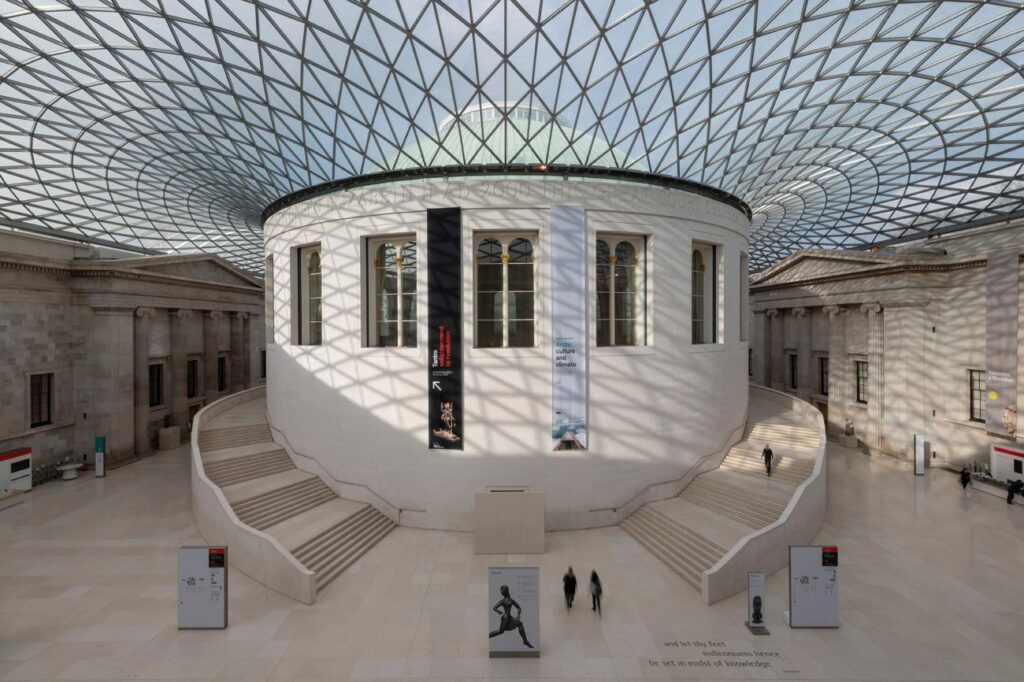
The British Museum, known for its vast and diverse collection, has embraced technology to enhance the visitor experience. It offers a virtual tour that allows visitors to explore the museum from the comfort of their homes. Additionally, the museum’s mobile app provides detailed information about the exhibits, including audio guides that delve into the history and significance of each artifact.
2. The Museum of Modern Art (MoMA), New York
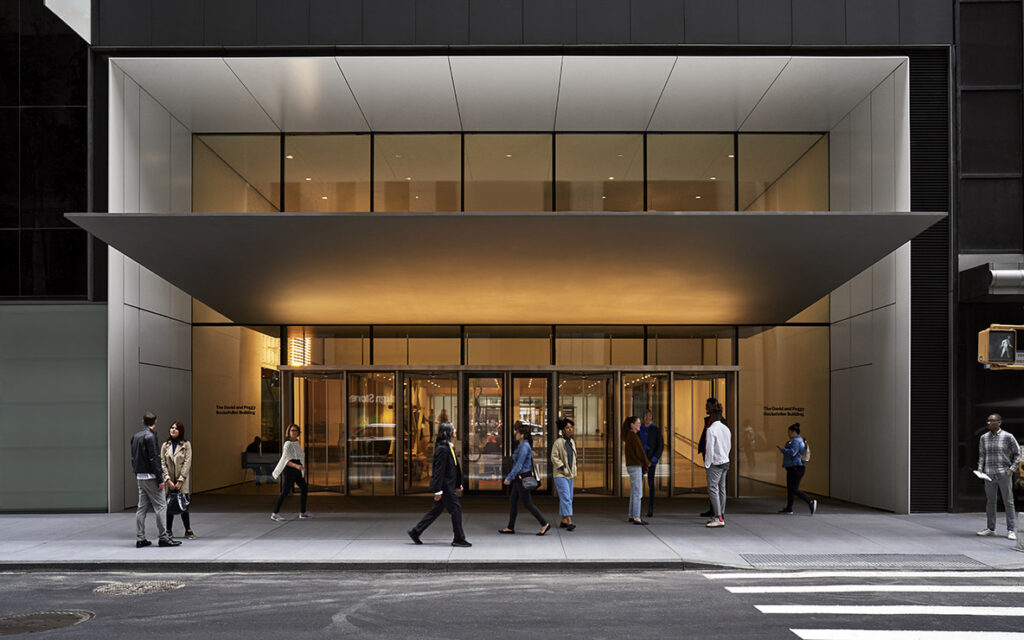
MoMA is renowned for its exceptional collection of modern and contemporary art. To offer visitors a more interactive experience, they introduced an audio tour using cutting-edge technology. The audio guide features commentary from artists, curators, and experts, providing a deeper understanding of the artworks.
3. The National Museum of Emerging Science and Innovation, Tokyo
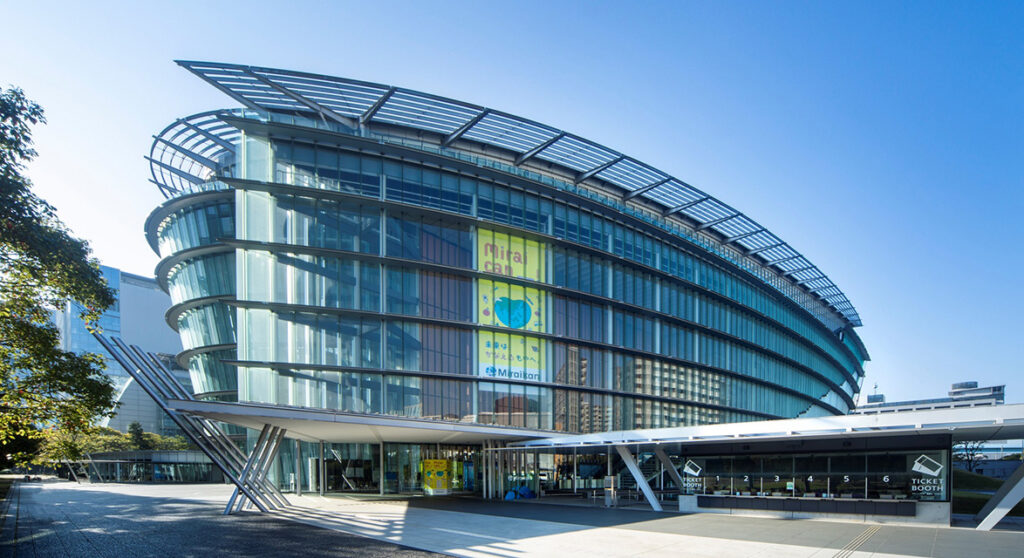
This museum takes technology to the next level. It offers visitors an immersive experience through VR exhibits. One notable exhibit allows visitors to virtually explore the International Space Station, providing an authentic glimpse into life in space.
4. The Rijksmuseum, Amsterdam
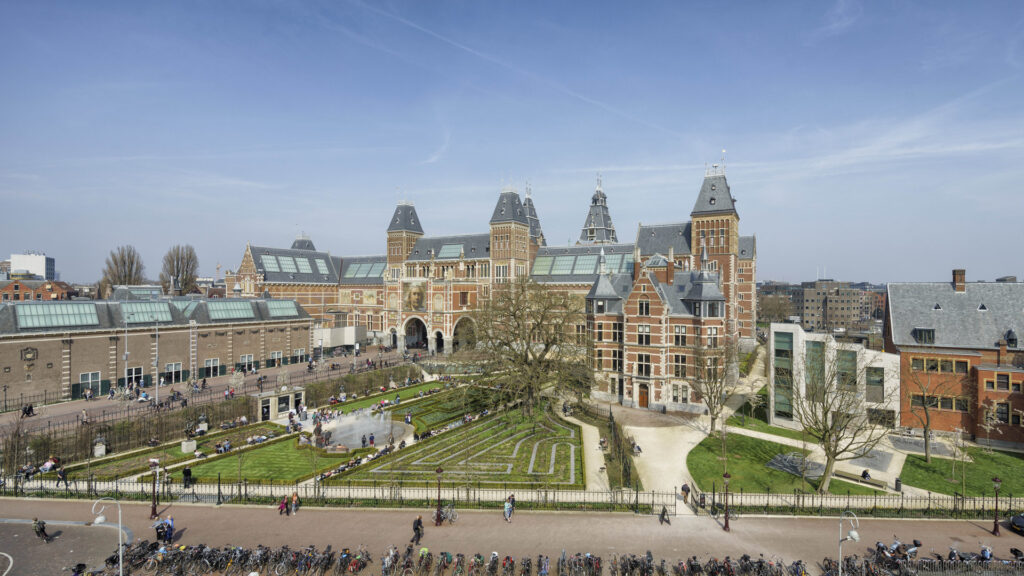
The Rijksmuseum uses technology to bring its paintings to life. Visitors can use an AR mobile app to animate famous works by artists such as Rembrandt, giving a dynamic view of the creative process behind these masterpieces.
In today’s world, museums are no longer silent spaces where history and art are locked in glass cabinets. They have become living, breathing entities that respond to the desires of modern visitors. Cutting-edge technology has played a pivotal role in this transformation, allowing museums to offer experiences that are not only informative but also interactive and memorable.
Interactive and Immersive Exhibits: A Journey Beyond the Glass
The world of museums is no longer confined to static displays behind glass. It has transformed into a dynamic, interactive realm where visitors are not just observers but active participants. This transformation is powered by the rise of interactive and immersive exhibits, which include touchscreens, 3D displays, and virtual tours. In this section, we’ll journey through these exhibits, exploring how they engage visitors and infuse the learning experience with enjoyment and fascination.
The Emergence of Interactive and Immersive Exhibits
The traditional concept of a museum visit, where one silently observes artifacts and paintings, has given way to a new era of engagement. Interactive and immersive exhibits are the cornerstone of this evolution. They include:
1. Touchscreens
Touchscreen displays have become a staple in museums. These exhibits allow visitors to interact directly with the content. For example, a touchscreen may enable visitors to zoom in on a painting to scrutinize brushstrokes or dive into the intricate details of an artifact. This level of interaction makes the museum experience more personalized and enriching.
2. 3D Displays
Three-dimensional displays create a sense of depth and realism that traditional exhibits often lack. Visitors can explore objects from every angle, gaining a deeper understanding of their structure and historical context. For example, a 3D display of a dinosaur skeleton allows visitors to view the creature from all perspectives, enhancing their comprehension of its anatomy and lifestyle.
3. Virtual Tours
Virtual tours have transcended the limitations of physical space. They transport visitors to distant locations, historical eras, or fictional worlds. Virtual tours make learning more enjoyable by immersing visitors in the subject matter. For instance, a virtual tour of an ancient city enables visitors to walk through its streets, witness daily life, and learn about its culture.
Engaging Visitors and Enhancing Learning
The advent of interactive and immersive exhibits has redefined the museum experience, making it more engaging and enjoyable. These exhibits offer several benefits:
1. Active Learning
Interactive exhibits encourage active learning. Visitors can manipulate content, ask questions, and experiment, making learning more dynamic. This hands-on approach fosters a deeper understanding of the subject matter.
2. Personalized Exploration
With touchscreens and 3D displays, visitors can explore exhibits at their own pace and based on their interests. This personalized experience allows visitors to focus on what intrigues them the most.
3. Multisensory Engagement
Immersive exhibits stimulate multiple senses, making the experience more memorable. For example, a virtual rainforest tour can include sounds and scents transporting visitors to the jungle’s heart, creating a multisensory adventure.
4. Storytelling
Interactive and immersive exhibits often employ storytelling techniques. These narratives draw visitors into the subject, making it relatable and captivating. Whether it’s an ancient civilization’s story or an artistic genius’s journey, storytelling adds depth and context.
5. Accessibility and Inclusivity
These exhibits are designed to cater to a diverse audience, including those with disabilities. Touchscreens can be equipped with braille labels and tactile elements, making the museum experience accessible.
6. Entertainment and Enjoyment
Immersive exhibits provide an element of entertainment, making learning enjoyable. Whether stepping inside a famous painting, virtual diving into the ocean, or exploring the cosmos, these experiences often feel more like an adventure than a lesson.
A Glimpse into the Future
As technology advances, the potential for interactive and immersive museum exhibits is boundless. Visitors can look forward to even more immersive experiences, where they can virtually step into historical events, interact with long-extinct creatures, or explore distant planets.
The rise of interactive and immersive exhibits has brought a wave of enjoyment and fascination to museums. Museums have evolved from places of quiet observation to spaces where learning is dynamic, memorable, and thrilling.
Collaboration and Thematic Exhibits: A Fusion of Creativity and Culture
Once solitary bastions of history and art, museums are embracing a new trend revolutionizing how we experience culture and knowledge. The trend of museums collaborating with other institutions and artists to create themed exhibits has breathed fresh life into these venerable institutions. This section will explore the exciting world of collaborative and thematic exhibits, delving into how these partnerships bring a diverse and vibrant perspective to the museum landscape.
The Rise of Collaborative and Thematic Exhibits
Traditionally, museums operated independently, curating and displaying their collections within their walls. However, the emergence of collaborative and thematic exhibits has introduced a new paradigm in the museum world. This trend involves:
1. Collaborations with Other Institutions
Museums are increasingly partnering with other institutions, such as universities, libraries, and research centers. These collaborations open access to a broader pool of resources, expertise, and knowledge. Museums that once worked in isolation are now joining forces to curate informative and diverse exhibits.
2. Partnerships with Artists
Artists of various disciplines, from painters and sculptors to filmmakers and musicians, are finding their place in the museum world. Museums invite artists to contribute their creativity to exhibits, creating an exciting fusion of artistic expression and historical or scientific narratives.
3. Thematic Exhibits
Thematic exhibits revolve around a central idea or concept rather than a specific time or collection category. These exhibits draw on the expertise of curators, historians, scientists, and artists to create a rich and immersive narrative.
The Diversity and Fresh Perspective of Collaborative Exhibits
Collaborative and thematic exhibits offer numerous advantages to both museums and visitors. These exhibits:
1. Cross-Pollination of Ideas
Collaborations bring together experts from various fields. When curators work with scientists or artists collaborate with historians, the result is a cross-pollination of ideas that enriches the exhibit.
2. Broader Access to Artifacts and Resources
Collaborations enable museums to access artifacts, documents, and resources they may not have within their collections. This broadens the scope and diversity of exhibits.
3. Fresh Interpretations
Artists and creative thinkers provide fresh interpretations of historical or scientific narratives. Their unique perspectives breathe life into the subject matter and make it more relatable to visitors.
4. Multisensory Engagement
Collaborative exhibits often include sensory elements, such as music, visual art, or performance, which engage multiple senses and create a more immersive experience for visitors.
5. Community Involvement
Thematic exhibits, especially those that revolve around local or cultural themes, often involve the community. This fosters a sense of belonging and participation, making the museum a vibrant part of the community.
6. Challenging Assumptions
Thematic exhibits encourage visitors to think differently and question assumptions. These exhibits promote critical thinking and open dialogue by presenting topics from multiple angles.
A Glimpse into the Collaborative World of Museums
1. The Louvre Abu Dhabi
The Louvre Abu Dhabi is a prime example of international collaboration. The museum collaborated with the Louvre in Paris to showcase artworks from different cultures, eras, and regions. This partnership brought together diverse perspectives, making it a cultural bridge between East and West.
2. The Museum of Modern Art (MoMA) and Jazz at Lincoln Center
MoMA and Jazz at Lincoln Center collaborated to create “Museum Dance-Off: A Tribute to the Trailblazers.” This thematic exhibit explored the connection between visual art and music, presenting a dynamic narrative that combined visual art with live jazz performances.
3. The Canadian Museum of History and the Musée de la civilization
These two Canadian museums collaborated to create “Canada: Day 1,” an exhibit that tells the story of Canada’s history through personal experiences. This thematic exhibit featured oral history recordings, videos, and personal artifacts, offering a diverse and engaging perspective on the country’s history.
Collaborative and thematic exhibits are redefining the museum experience, infusing it with diversity, creativity, and fresh perspectives. Visitors can now explore history, art, and science in informative and exciting ways.
Must-See Exhibits Around the Globe: A Tour of Artistic Wonders and Cultural Marvels
The world of museums is a treasure trove of art, history, science, and culture. Yet, certain exhibits stand out, captivating audiences worldwide and garnering international attention and acclaim. In this section, we embark on a global journey to explore must-see exhibits and attractions at renowned museums. These exceptional showcases serve as beacons of creativity, knowledge, and cultural exchange, drawing visitors from around the globe.
The Louvre, Paris, France: The Mona Lisa
The Louvre is a sanctuary of art, and at its heart resides the enigmatic Mona Lisa, a masterpiece by Leonardo da Vinci. This iconic painting, known for the subject’s enigmatic smile, has captivated art enthusiasts for centuries. The Mona Lisa’s allure lies not only in her cryptic expression but also in her rich history and cultural significance. Visitors from all over the world gather in the Louvre’s hallowed halls to glimpse this artistic wonder.
The British Museum, London, UK: The Rosetta Stone
The British Museum has many historical treasures, but none are as famous as the Rosetta Stone. This artifact is the key to deciphering hieroglyphs and understanding ancient Egyptian history. It’s an emblem of human ingenuity and curiosity, drawing visitors from across the globe who seek to unlock the secrets of the past.
The Metropolitan Museum of Art, New York, USA: The Temple of Dendur
The Temple of Dendur, an ancient Egyptian temple, is a striking centerpiece at The Met. It offers visitors a unique opportunity to step back in time and experience the grandeur of ancient Egypt. The exhibit provides a sense of wonder and awe, transporting visitors to another era.
The Vatican Museums, Vatican City: The Sistine Chapel
The Vatican Museums are home to a treasure trove of art and history, but the Sistine Chapel stands out as a true marvel. Michelangelo’s stunning frescoes, including the iconic “Creation of Adam,” adorn the chapel’s ceiling. These artworks are celebrated for their artistry and religious significance, making the Sistine Chapel a place of pilgrimage for art enthusiasts and the faithful alike.
The State Hermitage Museum, St. Petersburg, Russia: The Winter Palace
The State Hermitage Museum’s Winter Palace is not just a historical monument but a testament to the luxury of imperial Russia. Visitors flock to this grand exhibit to witness the extravagance of the Russian royal court and to explore its vast collection of art, including works by Rembrandt and Leonardo da Vinci.
The Acropolis Museum, Athens, Greece: The Parthenon Marbles
The Acropolis Museum is a modern architectural wonder designed to showcase the ancient artifacts of the Acropolis. One of its most famous exhibits is the Parthenon Marbles, also known as the Elgin Marbles. These sculptures are part of a contentious historical debate but remain a symbol of Greece’s rich cultural heritage, attracting visitors interested in art and history.
The Tokyo National Museum, Tokyo, Japan: The Japanese Gallery
The Tokyo National Museum boasts a remarkable Japanese art and cultural collection. It offers visitors a deep dive into Japan’s history and traditions. The museum’s Japanese Gallery showcases exquisite art, ceramics, textiles, and religious artifacts, making it a must-visit for Japanese culture and art.
The Australian Museum, Sydney, Australia: The Australian Aboriginal Art Collection
The Australian Museum’s Aboriginal Art Collection provides a unique window into the world’s oldest continuous culture. This exhibit showcases indigenous art, artifacts, and captivating and educational stories. It’s a tribute to the richness of Australian Aboriginal heritage and an essential visit for those interested in indigenous cultures.
The National Museum of Anthropology, Mexico City, Mexico: The Aztec Calendar Stone
The Aztec Calendar Stone, also known as the Sun Stone, symbolizes Aztec culture and history. This enormous basalt stone disc is intricately carved with complex iconography. It’s an impressive artifact that draws history enthusiasts and those intrigued by ancient civilizations.
The National Museum of China, Beijing, China: The Ancient China Exhibit
The National Museum of China showcases the rich history of this vast nation. The Ancient China Exhibit is a comprehensive journey through millennia of Chinese civilization. Visitors can explore artifacts from different dynasties, ancient calligraphy, and treasures from the Silk Road, making it a must-visit for those seeking insights into China’s history and culture.
These exceptional exhibits at renowned museums worldwide are more than just showcases of art, history, or culture; they are windows into the human experience. Each exhibit tells a unique story, engages the senses, and offers cultural exchange and education opportunities.
Local Treasures: Uncovering Hidden Gems in Museums Near You
While renowned museums like the Louvre, the British Museum, and the Met draw international crowds, the world of museums is not confined to famous institutions. In every region and community, hidden gems are waiting to be discovered. These lesser-known museums house unique exhibits and attractions celebrating local history, culture, and creativity. This section will explore some of these local treasures, encouraging readers to explore museums in their communities and unearth the often-overlooked stories.
The Small Town Art Gallery
Small towns and villages often boast charming art galleries that showcase local talent. These galleries offer a glimpse into the artistic pulse of a community. They feature paintings, sculptures, and crafts created by talented individuals who may not be internationally renowned but are deeply connected to the local culture.
Why Visit?: Small-town art galleries provide a platform for local artists to share their creativity and reflect the essence of their community.
The Quirky and Niche Museums
Sometimes, museums focus on the most unusual and specific subjects. You might find a museum dedicated to rubber ducks, lawnmowers, or vintage typewriters. These quirky museums offer an offbeat and memorable experience, providing insights into the fascinating subcultures of collectors and enthusiasts.
Why Visit?: Quirky museums offer a one-of-a-kind adventure and a deep dive into niche interests.
The Historical Society Museum
Many communities have historical society museums that house treasures related to the region’s past. These museums contain artifacts, photographs, and documents that chronicle the area’s history, from its early days to more recent events. They offer a valuable perspective on how the community has evolved.
Why Visit?: Historical society museums provide a unique opportunity to connect with the local heritage and gain a profound understanding of the community’s roots.
The Nature and Wildlife Centers
Nature and wildlife centers often serve as educational hubs for understanding the local environment and its inhabitants. These centers feature exhibits on local flora and fauna, offering insights into the region’s ecosystems. Visitors can learn about indigenous plants and animals, conservation efforts, and the importance of preserving local biodiversity.
Why Visit?: Nature and wildlife centers promote environmental awareness and foster a deeper connection with the local ecosystem.
The Heritage and Cultural Museums
Communities with rich cultural traditions often have heritage museums celebrating their history and customs. These museums may display traditional clothing, artifacts, artwork, and documents that tell the story of the local culture. They offer a chance to immerse oneself in the traditions and values of the community.
Why Visit?: Heritage and cultural museums provide an opportunity to appreciate the diversity and unique traditions that enrich the community.
The Interactive Children’s Museums
Children’s museums are dynamic spaces designed to engage young minds. They feature interactive exhibits that encourage learning through play. These educational and fun museums make them an excellent choice for families with young children.
Why Visit?: Children’s museums stimulate curiosity and creativity in the community’s youngest members.
The Local Artist’s Studio or Workshop
In some regions, you can visit the studios and workshops of local artists. These spaces provide a behind-the-scenes look at the creative process, allowing visitors to witness artists at work and explore their masterpieces up close. It’s a unique opportunity to interact with the artistic community and support local talent.
Why Visit?: Artist studios and workshops offer an intimate and personal connection with the local art scene.
The Rural Life and Agricultural Museums
Rural areas often have museums that showcase the agricultural heritage of the region. These museums house farming equipment, tools, and artifacts that have significantly shaped the local economy and way of life.
Why Visit?: Rural life and agricultural museums offer a window into the farming traditions that have sustained the community for generations.
The Local Science and Technology Centers
Many towns and cities have science and technology centers that introduce visitors to the wonders of science and innovation. These centers often feature interactive exhibits and hands-on experiments, making learning about science enjoyable and accessible.
Why Visit?: Local science and technology centers inspire curiosity and a love for scientific exploration.
The Educational University Museums
University campuses are home to museums often overlooked by the general public. These museums may focus on archaeology, art, or natural history. They offer a unique blend of academic research and public education.
Why Visit?: University museums bridge academic knowledge and the wider community, allowing visitors to engage with ongoing research.
Every community has stories to tell, traditions to celebrate, and talents to showcase. By exploring local museums, you enrich your understanding and contribute to preserving and appreciating the cultural and historical treasures within your community. These local treasures may be hidden gems but are no less valuable and significant than their internationally acclaimed counterparts.
Accessibility and Inclusivity: Opening the Doors of Museums to All
Museums are more than repositories of art, history, and culture; they are gateways to knowledge and enlightenment. These gateways must be accessible to everyone, regardless of their physical abilities or disabilities. In this section, we will explore the importance of making museums accessible and inclusive for all visitors and highlight examples of museums leading the way in providing accessible exhibits and services.
The Importance of Accessibility
1. Equal Opportunities: Accessibility ensures that everyone has equal opportunities to access and engage with museums’ wealth of knowledge and culture. It upholds the principles of fairness and justice.
2. Diverse Audiences: Museums cater to diverse audiences. Some visitors may have mobility challenges, sensory impairments, or cognitive disabilities. Ensuring accessibility means reaching out to these audiences and fostering a sense of belonging.
3. Promoting Inclusivity: An inclusive museum is a welcoming space that promotes diversity and celebrates different abilities. It sends a powerful message of acceptance and respect.
4. Compliance with Laws: In many countries, accessibility is a legal requirement. Museums must comply with legislation such as the Americans with Disabilities Act (ADA) in the United States and similar laws worldwide.
Making Museums Accessible
1. Physical Accessibility: Museums must have ramps, elevators, and accessible restrooms to accommodate visitors with mobility challenges. Exhibits should be reachable by wheelchair users, and pathways should be obstacle-free.
2. Sensory Accessibility: Museums can provide guided tours for visitors with visual or hearing impairments. Tactile exhibits, audio guides, and sign language interpreters can enhance the experience.
3. Cognitive Accessibility: Museums can create easy-to-read materials and offer quiet spaces for visitors with cognitive disabilities. Simple language and clear graphics make exhibits more understandable.
4. Virtual Accessibility: In the digital age, virtual exhibits and online resources must also be accessible. Websites and apps should follow accessibility guidelines to ensure screen readers and assistive technology compatibility.
Leading Museums in Accessibility
1. The Louvre, Paris, France: The Louvre provides sensory tours for visitors with visual or hearing impairments. They offer tactile experiences and audio guides that describe artworks in detail.
2. The Museum of Modern Art (MoMA), New York, USA: MoMA offers a variety of accessibility programs, including sign language tours, touch tours, and art-making programs for visitors with dementia.
3. The National Gallery, London, UK: The National Gallery provides free audio guides with audio descriptions of paintings. They also have wheelchairs, accessible entrances, and sign-language interpreters.
4. The Australian Museum, Sydney, Australia: This museum was awarded for its commitment to accessibility, including tactile and sensory exhibits, guided tours, and a quiet room for visitors with sensory sensitivities.
5. The Van Gogh Museum, Amsterdam, Netherlands: The Van Gogh Museum offers multi-sensory tours and has implemented universal design principles throughout the museum, ensuring accessibility for all.
The Journey Towards Greater Inclusivity
Museums are on a journey toward greater inclusivity, and the path is marked by continuous improvement. They are listening to the needs and concerns of visitors with disabilities and making changes that benefit everyone. By embracing accessibility, museums enrich the visitor experience and expand their impact on society.
1. Training and Awareness: Museums train staff and volunteers to understand the needs of visitors with disabilities. This leads to a more empathetic and inclusive environment.
2. Consultation with the Community: Museums involve the disability community in decision-making processes. This ensures that accessibility solutions are practical and effective.
3. Feedback Loops: Museums encourage feedback from visitors and use it to drive improvements. Regular assessments and updates keep accessibility initiatives relevant.
4. Technology and Innovation: Museums embrace technology to create accessible exhibits. This includes interactive digital experiences that cater to diverse needs.
A Museum for All
The vision of an accessible and inclusive museum is a museum for all. One that opens its doors to every community member, inviting them to explore, learn, and engage. It’s a space where diversity is celebrated, and differences are bridges to understanding. As museums evolve and adapt, they convey that knowledge and culture are not exclusive but for everyone. In the final section, we’ll conclude our exploration of the world of museums and encourage readers to embrace the museum experience in all its richness and diversity.
Embrace the Museum Experience
Whether vast institutions housing world-famous masterpieces or cozy local spaces celebrating community heritage, museums have an essential role in our lives. They are not merely repositories of artifacts and art; they are bridges to history, science, and the human spirit. Embracing the museum experience means immersing ourselves in the world’s vast and diverse knowledge and culture while celebrating continuous efforts toward accessibility and inclusivity.
1. Discovering the Unseen: Beyond the well-known exhibitions, the hidden gems in museums often provide the most profound experiences. Take time to explore lesser-known collections and exhibitions. You may stumble upon a masterpiece or an artifact that resonates with your soul.
2. Encourage Engagement: Participate in museum programs and events. Attend guided tours, workshops, and lectures. These activities enrich your understanding and allow you to connect with like-minded individuals who share your interests.
3. Support Inclusivity: When you visit museums, consider accessibility. Support museums that prioritize inclusivity and actively seek to make their exhibits welcoming. Your patronage encourages them to continue their efforts in this direction.
4. Share the Experience: Encourage family and friends to join you on your museum adventures. The more people who partake in museums’ cultural and educational experiences, the greater the impact on society.
5. Continual Exploration: Make museum visits a regular part of your life. As exhibitions change and new programs are introduced, each visit can be a fresh opportunity to learn, reflect, and be inspired.
6. Feedback and Advocacy: Provide constructive feedback to museums about your positive experiences or areas that need improvement. Your input can contribute to their ongoing growth and commitment to excellence.
In the grand tapestry of human existence, museums are the vibrant threads that weave together the past, the present, and the future. They transcend boundaries, open doors to new worlds, and remind us of our shared history and the boundless possibilities of the human imagination. By embracing the museum experience in all its richness and diversity, we become active participants in the ongoing journey of discovery and enlightenment.
In our exploration of museums, we have traversed through the corridors of knowledge and creativity, from must-see exhibits around the globe to local treasures that tell unique stories. We’ve delved into the role of education in museums, which transforms passive visits into dynamic learning experiences. And we’ve acknowledged the importance of accessibility and inclusivity, ensuring that the treasure troves of museums are accessible to everyone.
Conclusion: A Journey Through the Enriching World of Museums
As we conclude our journey through the world of museums, it’s clear that these institutions are not merely buildings filled with relics and art but rather profound gateways to human knowledge, creativity, and culture. Museums transcend time and place, beckoning us to explore the past, celebrate the present, and ponder the future. Our exploration has taken us through diverse topics, from must-see exhibits in renowned museums to hidden gems in our local communities. We’ve delved into the role of education within these institutions and uncovered the vital importance of accessibility and inclusivity. Here, we encapsulate the enriching world of museums, highlighting their enduring significance and the boundless potential they offer to all.
Museums: Keepers of the Past
Museums are custodians of history, preserving the collective memory of humanity. They hold in their archives the stories of ancient civilizations, the brushstrokes of master artists, and the inventions that shaped our world. Walking through the halls of museums, we are transported through time, tracing the footsteps of our forebears and gaining a profound appreciation for the tapestry of human existence.
Museums: Inspirers of the Present
Museums are not just mausoleums of the past; they are vibrant sources of inspiration for the present. They stimulate creativity, ignite curiosity, and encourage us to question, learn, and dream. Museums are places where science, art, and culture converge to kindle the flames of innovation.
Museums: Shapers of the Future
In our exploration, we have witnessed the educational role of museums, which extends far beyond their walls. They provide spaces for lifelong learning, nurturing a culture of curiosity that stretches into the future. Museums inspire the next generation of scientists, artists, historians, and dreamers, shaping the course of human progress.
Museums: Beacons of Inclusivity
We have also delved into accessibility and inclusivity, recognizing the importance of ensuring museums are open to all. Museums have moved beyond physical barriers and reached out to individuals with various abilities, ensuring everyone can experience the richness they offer.
The Future of Museums
Museums are not static but dynamic, ever-evolving entities that reflect the changing landscape of human knowledge and cultural values. The future of museums holds exciting possibilities, from integrating cutting-edge technology to expanding collaborative and themed exhibits. Museums will continue to engage, educate, and inspire, striving for even greater accessibility and inclusivity.
Your Museum Journey
Our journey through the world of museums is not the end; it is an invitation to embark on your exploration. The world of museums is rich and diverse, and treasures await to be discovered in your community and beyond. By stepping into a museum, you are stepping into a world of wonder, knowledge, and inspiration.
So, whether you are a seasoned museum-goer or someone contemplating your first visit, remember that museums are living testaments to the beauty of human creativity, the depth of human history, and the breadth of human potential. Museums are here to celebrate our shared past, illuminate our present, and inspire our collective future. It is a journey worth taking, a journey through the enriching world of museums.

